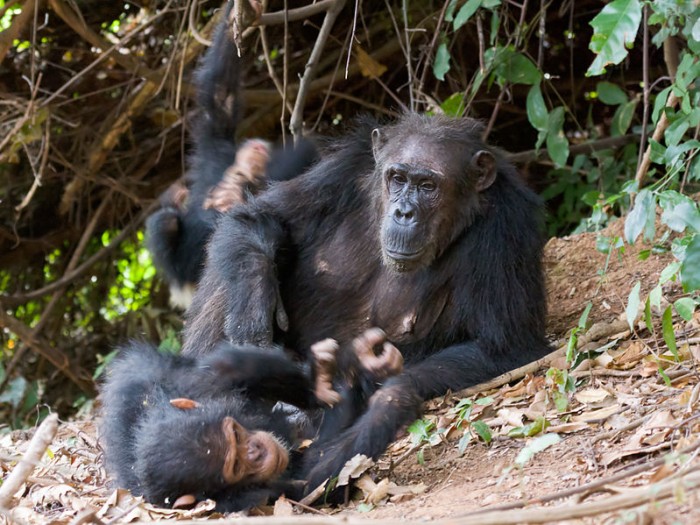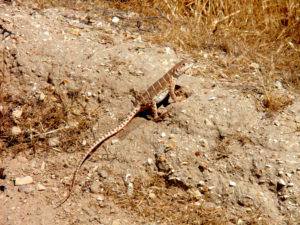Primates in Peril
Primates may be our closest relatives but we are causing them serious harm. A comprehensive review of the influence of human activities on wild primate populations in four countries has found that they are facing major threats.
 Image: By Ikiwaner (Own work) [GFDL 1.2 (http://www.gnu.org/licenses/old-licenses/fdl-1.2.html)], via Wikimedia Commons
Image: By Ikiwaner (Own work) [GFDL 1.2 (http://www.gnu.org/licenses/old-licenses/fdl-1.2.html)], via Wikimedia Commons
Primates are fascinating animals. They are intelligent, live in complex societies and are a vital part of the ecosystem. Primates that eat a diet consisting of a high proportion of fruits play an important role as seed dispersers. They also have a role as predators, prey, competitors for resources and help to maintain a healthy forest habitat.
Lemurs, lorises, galagos, tarsiers, monkeys and apes are our closest biological relatives. The human population has spread to all corners of the Earth, yet many of our primate relatives are under serious threat. In a study published last month, an international team of leading primate researchers has analysed and evaluated the situation of many endangered non-human primate species in Brazil, Madagascar, Indonesia and the Democratic Republic of the Congo. In this, the researchers investigated the influence of human activities on wild primate populations.
The destruction of natural forests and their conversion into agricultural land threatens many species because their habitat is lost. A simulation of agricultural land expansion by the end of this century showed a decline of up to 78% in the distribution areas of many primate species. Additionally, hunting and the bushmeat trade has led to a massive and rapid decline of many populations. In their study, the scientists ask for immediate measures to protect the endangered primate species and make recommendations for the long-term conservation of primates and to avert primate extinction.
Primates live in tropical and subtropical areas and are mainly found in regions of Africa, South America, Madagascar and Asia, in a total of 90 countries. The International Union for Conservation of Nature (IUCN) currently lists 439 species. Sixty-five percent (286) of these are located in the four countries featured in the study – Brazil, Indonesia, Madagascar and the Democratic Republic of Congo. Around 60% of them are threatened by extinction. Particularly dire is the situation in Indonesia and Madagascar, where 90% of primate populations have declined and more than three-quarters of species are endangered.
The authors of the study conducted a comprehensive literature review, analysing the major threat factors for primates in the four countries. In Brazil, Madagascar and Indonesia the increasing destruction of their habitats is a major stressor for the animals. In the Democratic Republic of the Congo, the bushmeat trade is the biggest threat. In addition, primates are sold illegally as pets or used in traditional medicine. Poverty, the lack of education, food insecurity, political instability and corruption further encourage the depletion of natural resources in the countries concerned and make it more difficult to protect the animals.
Underlying all of these issues is the pressure exerted by a growing human population in each of the countries. Projections for the year 2050 indicate continued population growth in all of them, extending the human footprint on primate habitats and increasing demand and environmental destruction.
Christian Roos, a scientist in the Primate Genetics Laboratory at the DPZ and co-author of the study said: “The destruction of the natural environment through deforestation, the expansion of agricultural land and infrastructure development to transport goods has become a major problem. The main contributors of this development are the industrial nations. There is a high demand for raw materials such as soy, palm oil, rubber, hardwood or fossil fuel. The four primate-rich countries cover 50% of these export goods to China, India, the US and Europe.”
The scientists combined data from the United Nations and World Bank to simulate the estimated spread of agricultural land in the four countries until the turn of the century. Assuming a worst-case scenario, the researchers were able to predict a decline in the geographical range of the primate populations. By the year 2100, 78% of the primate habitats in Brazil, 72% in Indonesia, 62% in Madagascar and 32% in the Congo could have disappeared.
Also investigated by the authors was the size and distribution of protected areas. Their estimates show that Brazil and Madagascar have around 38%, Indonesia 17%, and the Democratic Republic of Congo 14% of primate habitats in protected areas. The majority of the distribution areas are without protection status and primates are therefore under threat.
One emerging threat identified in the study is disease. Across human-dominated landscapes, primates are exposed to emerging infectious diseases caused by increased contact with human and domesticated animals. Periodic outbreaks of a disease across a broad region can result in local primate population declines or losses from otherwise suitable habitat. An example of this is outbreak of Ebola in the Lossi Sanctuary in the northern Republic of Congo, which killed over 90% of the western gorillas and possibly 80% of chimpanzees.
Climate change is of course a threat to many species. Although the impact of local and global climate change on primate populations is limited, current assessments indicate the expected extremes in temperature and rainfall will put primates at significant risk. Climate change projections suggest that Brazil’s four endemic species of Atlantic forest lion tamarins will experience major shifts and/or reductions in habitat suitability in the coming decades. Similarly, the distribution of the northern muriqui is expected to be reduced by more than half of its present area, with a large decline in the future suitability of currently protected reserves due to climate change.
The authors call for the extension of protected areas, the reforestation of forests and the planting of corridors between habitats as important measures to preserve primate populations. In addition, the local population must be made aware of the precarious situation. Governments, scientists, conservation organisations and economists need to work together to promote sustainable, organic farming while preserving traditional lifestyles. And the governments of the countries concerned should work harder to combat illegal hunting, forest destruction and primate trade.
“Primates are like canaries in a coal mine,” says Christian Roos. “They are invaluable for tropical biodiversity as they are vital for the regeneration of forests and stable ecosystems. Their extinction will serve as an alarm bell for humans and an indication that these habitats will become unusable in the long run.”





Sorry, comments are closed on this post